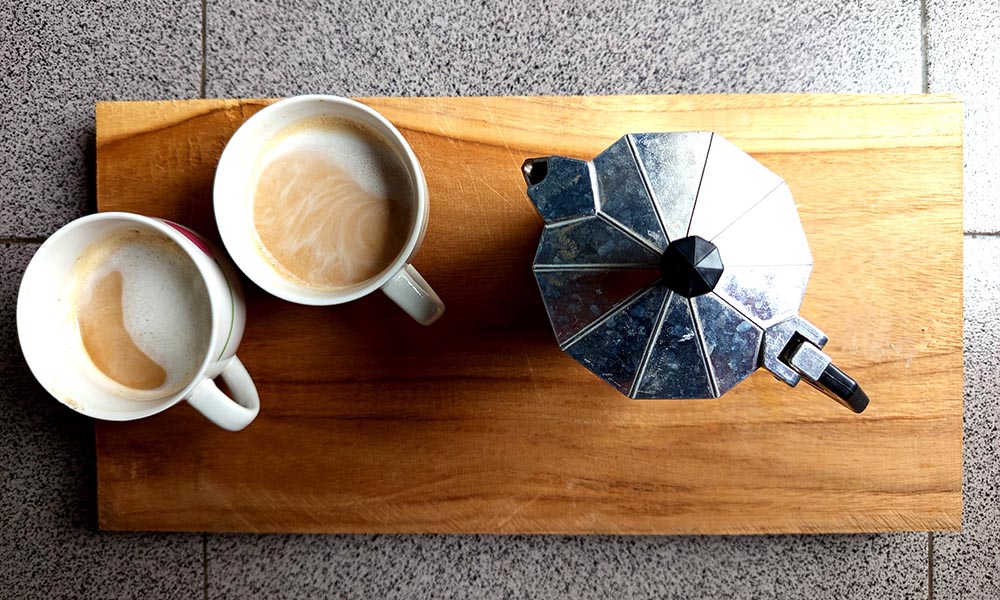

Milk coffee is one of the most beloved beverages in the world and a timeless classic of the Italian breakfast. Despite its simplicity, this drink carries history, tradition, and an art that lies in the perfect balance between coffee and warm milk. Often confused with latte macchiato or cappuccino, Milk coffee has its own identity and a unique taste, ideal for those who prefer a sweeter and milder coffee experience. In this article, we will explore the origins and history of this drink, discover how Milk coffee has spread and won over coffee lovers worldwide, and learn how to prepare it perfectly at home.
Origins and history of milk coffee
The history of Milk coffee is deeply rooted in Italian tradition, where for generations, warm milk with coffee has been a morning staple for many families. The word “Milk coffee” comes from the Italian term that combines “caffè” (coffee) and “latte” (milk), indicating the two essential ingredients of this drink. In Italy, Milk coffee is often made using a moka pot, which gives it a smoother and less intense flavour compared to an espresso machine, making it particularly suitable for breakfast.
Over the years, Milk coffee has gained popularity in many parts of the world, evolving into local variations and adapting to different tastes. In many countries, for example, it is prepared with a shot of espresso and foamed milk—a version that has become widely known in the United States as “latte.” This has led to some confusion between the Italian Milk coffee and the American “latte,” but the essence of the Italian drink remains unique: simple, authentic, and comforting.
How to prepare milk coffee at home
Making the perfect Milk coffee is simple, but it requires attention to achieve the right balance between the intense flavour of coffee and the sweetness of milk. Here’s how to do it:
Ingredients:
- Coffee: The base can be made with moka coffee or espresso, using high-quality coffee blends. For a traditional Italian Milk coffee, the moka pot is often preferred for its rounder flavour.
- Milk: The milk should be heated without creating too much foam, maintaining a smooth and creamy consistency. You can use whole milk, semi-skimmed milk, or, if you prefer an alternative version, plant-based milk such as soy or oat milk.
Preparation steps:
- Make the coffee: Use a moka pot or an espresso machine to brew a hot and aromatic coffee. For a traditional Milk coffee, the coffee should make up about one-third of the final drink.
- Heat the milk: Pour the milk into a saucepan and warm it over low heat, making sure it doesn’t boil. If you like a touch of foam, use a milk frother or a whisk to create a light, creamy texture, but avoid making it too thick, as you would for a cappuccino.
- Combine the coffee and milk: Pour the coffee into a large cup, then gently add the warmed milk. Be sure to pour it slowly to maintain the contrast between the coffee and milk and to achieve a visually appealing and uniform drink.
For those who love to customise their Milk coffee, you can add a pinch of sugar, cocoa powder, or even a sprinkle of cinnamon. This small touch adds a special aroma and makes Milk coffee perfect for any time of day.
Milk coffee vs. latte macchiato: what’s the difference?
Although both drinks combine coffee and milk, Milk coffee and Latte Macchiato are distinct in both preparation and taste experience. The key difference lies in the coffee-to-milk ratio and the way they are mixed:
Milk coffee:
- In Milk coffee, the proportion of milk is greater than that of coffee. Traditionally, the drink is prepared with a cup of warm milk that is not excessively foamed (or only slightly creamy) and a smaller amount of coffee, about one-third of the total.
- The coffee is poured first into the cup, followed by the warm milk, creating a sweeter drink where the taste of milk is dominant, and the coffee adds aroma without overpowering it.
- In cafés, it is usually served in a large cup or a cappuccino cup, with a soft and velvety milk texture but without excessive foam.
Latte macchiato:
- Latte macchiato, on the other hand, is made by “staining” the milk with coffee. In this case, the milk is frothed to create a dense and consistent foam, similar to that used for cappuccino.
- The drink is served in a tall, transparent glass, where the foamed milk is poured first, leaving a visible layer of foam on top. Only then is an espresso added directly into the foam, creating a “stain” (hence the name) that remains visible in the glass.
- This method makes Latte Macchiato visually striking, with distinct layers of milk and coffee. For a barista, the technique requires careful layering and precise pouring of the coffee to achieve the desired aesthetic effect.
At a Café: milk coffee vs. latte macchiato
For baristas, distinguishing between Milk coffee and Latte Macchiato is essential, as the two drinks require different milk frothing and pouring techniques, and their presentation plays an important role in the customer’s experience. A well-made Milk coffee is smooth and uniform, with minimal foam, perfect for a simple and creamy breakfast. A Latte Macchiato, on the other hand, is characterised by its layered appearance, which needs to be precise and visually appealing, and by a rich, airy foam that enhances both the texture and aesthetics of the drink.
Milk coffee is much more than just a drink—it’s a daily ritual, a way to start the day with warmth and sweetness. Making it at home is a simple act that can turn an ordinary morning into a moment of genuine relaxation and pleasure. With just a few steps and a little care, you can create a Milk coffee with a balanced and enveloping flavour that will delight any coffee lover.
Whether you prefer a traditional Milk coffee made with a moka pot or a more modern version with espresso, this drink offers a comforting morning treat infused with Italian tradition. Enjoying a good Milk coffee is a small everyday luxury that makes even the simplest moment special.
